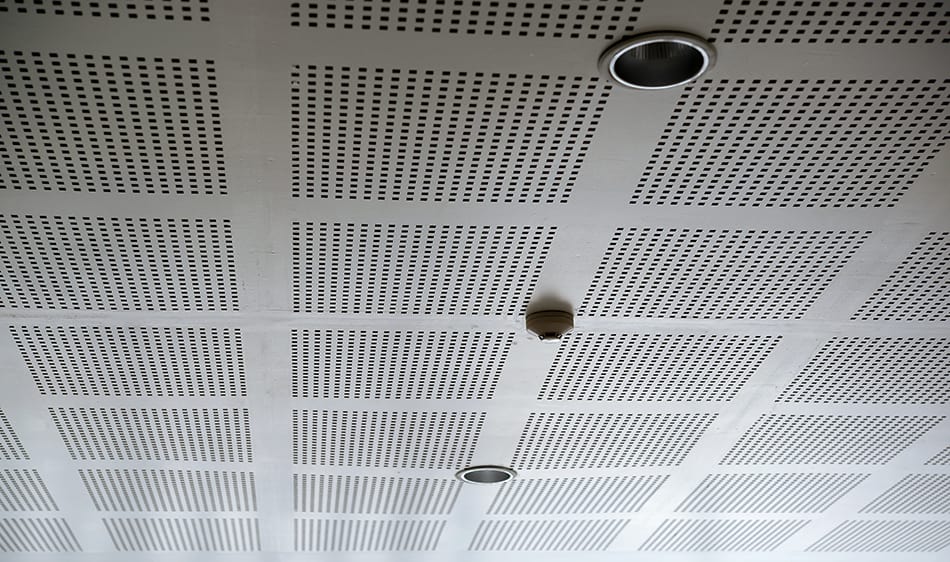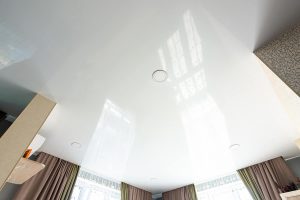Acoustic ceilings are proving to be a contemporary and practical solution to unappealing and empty-sounding rooms. These are now widely used not only in offices but also in schools and homes. You might be intrigued by the prospect of installing one at your abode. Find out more about acoustic ceilings, their types, pros, and cons in this article.
Many homeowners don’t like the experience of being in a room with poor acoustics. This is very much true in a room with hard surface floorings like concrete or ceramic tiles. The hard surface causes the sound in a room to bounce from wall to wall and from the ceiling to the floor. This creates an echoing sound that’s not exactly homey.
The noise generated by other family members or those living in the same household can also be too much or mind-numbing for some homeowners. For example, a teenager who listens to rock music can cause a distraction in the house. A kid who shouts while playing video games is another example. Even the noise from kitchen appliances humming can be bothersome.
While covering up the floor is one solution to these problems, a more practical approach is to install acoustic ceilings.
What Are Acoustic Ceilings?
Acoustic ceilings are a type of ceiling with soundproofing capabilities. Also known as a lay-in ceiling, it can dampen ambient noise, lower energy consumption, and help add a contemporary look to any room.
To better understand how an acoustic ceiling provides these benefits, it’s essential to determine how it works. Metal strips are placed and hung from the actual ceiling of a room. Then, panels of sound-absorbing materials are slid into the sections.
Acoustic ceilings are made from different materials. Most are manufactured from mineral fiber, a combination of materials ranging from clay, mineral fibers, perlite, and recycled newsprint. This is highly popular because of the material’s superior noise-reduction capabilities. Since it’s the most commonly produced acoustic ceiling material, it is also the most affordable.
Acoustic ceilings may also be made from fiberglass, which can come in different variations, such as polyurethane or PVC-bagged fiberglass and woven fabric. There’s also painted PVC-faced fiberglass that’s designed to appear like painted drywall.
Metal and wood are two other materials from which acoustic ceilings are made of. However, these two aren’t preferred because of their poor soundproofing properties.
These materials don’t absorb sound but instead, reflect it. Acoustic ceilings made of metal and wood usually have holes or slots where air passes through. Behind those holes are sound-absorbing fibers for acoustic purposes. Usually, metal and wood are used in commercial acoustic ceilings.
Other specialty materials used in acoustic ceilings include reinforced gypsum tiles, cementitious wood fibers, and acoustic foams.
What Are the Types of Acoustic Ceilings?
There are two basic styles of acoustic ceilings- dropped or suspended and glued ceilings. Let’s take a closer at both acoustic ceiling types.
Dropped or acoustic ceiling is the more common type. It typically comprises tiles (either 2×2 feet or 2×4 feet) dropped into an interlocking metal grid and suspended from the ceiling. The larger tile or panel is generally cheaper per piece. It can also cover a ceiling with fewer pieces. Installing the larger tile or panel is also generally faster.
On the other hand, glued ceilings are tiles that are directly glued onto the ceiling. These are tiles usually 1×1 foot in size. Both acoustic ceiling types offer soundproofing capabilities and cover up existing damage.
Regardless of the style, you’d likely come across the standard color of white or off-white. Still, you’ll love that the acoustic ceiling comes in many patterns and designs to match the look and feel of your home.
What Are the Pros and Cons of Acoustic Ceilings?
Pros
Absorb Sound or Noise
As mentioned earlier, acoustic ceilings are primarily used to absorb noise. These ceilings or tiles manage noise control in small or large areas, keeping the acoustics balanced for the comfort of its occupants.
This is one reason why acoustic ceilings are often used in business settings like offices. Unwanted noise in the office is often cited as one of the leading factors in the dissatisfaction of employees. It can also cause stress and reduce productivity in the process.
Moreover, unwanted noise in the office is often related to speech privacy, in which employees tend to hear unwanted and loud conversations from other people in the same workplace. With acoustic ceilings, that unwanted noise or sound from other people would be absorbed. Acoustic ceilings would prevent the noise from bouncing off into a nearby cubicle.
How much noise can acoustic ceilings absorb or reduce? Manufacturers of acoustic ceiling tiles say that high-performance tiles can reduce ambient noise by as much as 70%.
Hide Unsightly Necessities
Another advantage or benefit of an acoustic ceiling is that it hides things like pipes or wires or even design problems like old and cracked plaster. In case of repair or remodeling, the acoustic ceiling tiles can be easily removed. This explains why acoustic ceilings are widely preferred for basement remodels.
Save Money In the Long Run
Acoustic ceilings are highly reflective, meaning they let more light reflect into a room. This also means that you won’t have to switch on all the lights in the room if you have an acoustic ceiling. Installation of acoustic ceilings also lowers the ceiling height, and this provides additional insulation. Thus, you’ll have less space to heat with acoustic ceiling tiles, and this can make your energy bills lower.
Versatile and Easy to Maintenance
Acoustic ceilings are also flexible as these can be installed in most rooms. Maintenance is easy, too. You can easily clean the panels if soil or dust is on their finish. In case of damage, an acoustic ceiling can be easily replaced in a matter of minutes.
You can also get additional insulation and fire resistance for your house when you install acoustic ceilings. While the insulation offered by acoustic ceilings isn’t that significant, it can still help in cooling a drafty attic. Moreover, acoustic ceilings are fire-rated and can provide around 20 minutes of fire protection.
Disadvantages
Of course, acoustic ceilings have their share of disadvantages. One con is that an acoustic ceiling is not waterproof. Another concern is that acoustic ceilings can deteriorate over time, causing the tiles to sag.
However, as mentioned earlier, replacing acoustic ceilings is relatively easy. You also have the option to repaint them if the colors deteriorate or become dull.
What Are the Noise Reduction Capabilities of Acoustic Ceilings?
Now that you already have a basic knowledge of acoustic ceiling tiles and their benefits let’s take a closer look at the noise-reduction capabilities of these materials. There are three ways to measure or describe the sound absorption capabilities of acoustic ceilings. These are noise reduction coefficient (NRC), sound transmission class (STC), and ceiling attenuation class (CAC).
NRC is simply the measurement of a particular material’s ability to absorb sound. It is graded on a scale of 0 to 1. The higher the number is, the better the sound-absorbing quality of the material. Thus, if the material has an NRC rating of 0, then it cannot absorb sound. Now, if the material has an NRC rating of 1, then it means that it can absorb all the sound in a room.
Some of the best-selling acoustic ceiling panels have an NRC rating of 0.8 which can give you an idea of how capable they are in absorbing sound waves. Here’s an interesting bit of trivia: most acoustic panels in a typical recording studio have an NRC rating of 0.8.
Next up is the STC, a rating to indicate the effectiveness of a material at soundproofing. Just like in an NRC, the higher STC rating means a material is capable of preventing more sound from escaping or passing through.
The average STC rating of walls in standard homes is 35. A material with an STC rating of 50 would make it hard for you to hear a normal conversation. As far as acoustic ceiling goes, the good ones have an STC rating of the mid to high 20s. This means that these ceilings can only block a portion of noise coming from outside sources.
Finally, the CAC measures the capability of a ceiling to block sound and prevent it from transferring to another enclosed space. Again, the higher the rating is, the better the material or ceiling is at blocking sound.
An acoustic ceiling with a CAC rating of 25 or less is not ideal for use in the office or a corporate environment because it can let a lot of audio transfer. It’s recommended to use a ceiling with at least a 35 CAC rating as it can reduce noise bouncing from one room to another.
Costs of Acoustic Ceilings
As mentioned earlier, acoustic ceilings are a cost-effective solution to soundproofing your room and hiding unsightly pipes or wiring in the ceiling. You’d be surprised to learn that acoustic ceilings are relatively inexpensive, too.
It’s possible to get a 12×12-inch acoustic ceiling tile for less than $15. Of course, the price of installing acoustic ceilings will also depend on your room size.
Factors to Consider in Choosing Acoustic Ceilings or Tiles
Aside from the price, there are other things that you must consider when choosing an acoustic ceiling or tile.
First, you should consider the type of room you want to have the acoustic ceilings installed in. You should also determine your purpose. Do you want to prevent the sound from transferring out of the room? Or do you want to absorb reflections for better acoustics? These are some of the questions you need to answer.
Let’s cite some examples. If you’re installing acoustic ceilings in your living room where your home theater is located, you’d better off with sound-absorbing ceiling panels. This can result in better acoustics in the room with less noise and a cleaner sound for a theater-like movie experience.
But if you are trying to make your home office quiet and more conducive to working, then you’d want to block the noise coming from the other parts of your house. Perhaps you’re concerned about your kids playing in the next room. If this is the case, you should install acoustic ceilings with a high CAC rating, as these can block sound from getting into your home office.
You must also consider the installation of the acoustic ceiling. One common way to install it is through a drop ceiling, wherein you’d insert the tiles in a metal frame hanging below your current ceiling. But some tiles need to be stapled or glued to the ceiling to be installed.
This may sound like an easy method, but unfortunately, it doesn’t work for all acoustic ceiling tiles. Moreover, this method of installation can reduce the soundproofing of the acoustic ceiling.
After determining the ceiling tiles you’ll use, you need to figure out the number of tiles you’ll install for your home improvement project. You should measure the ceiling space in your room to do this. You can then order the right number of tiles to fit your ceiling.
Conclusion
To sum things up, acoustic ceilings can make a significant aesthetic and acoustic change in your room. It not only adds another dimension to the look and feel of your abode but also dampens or blocks noise.
Available in different colors and designs, an acoustic ceiling can even make your room more inviting. Other benefits of an acoustic ceiling include lowering energy consumption and hiding unsightly wires and pipes.








